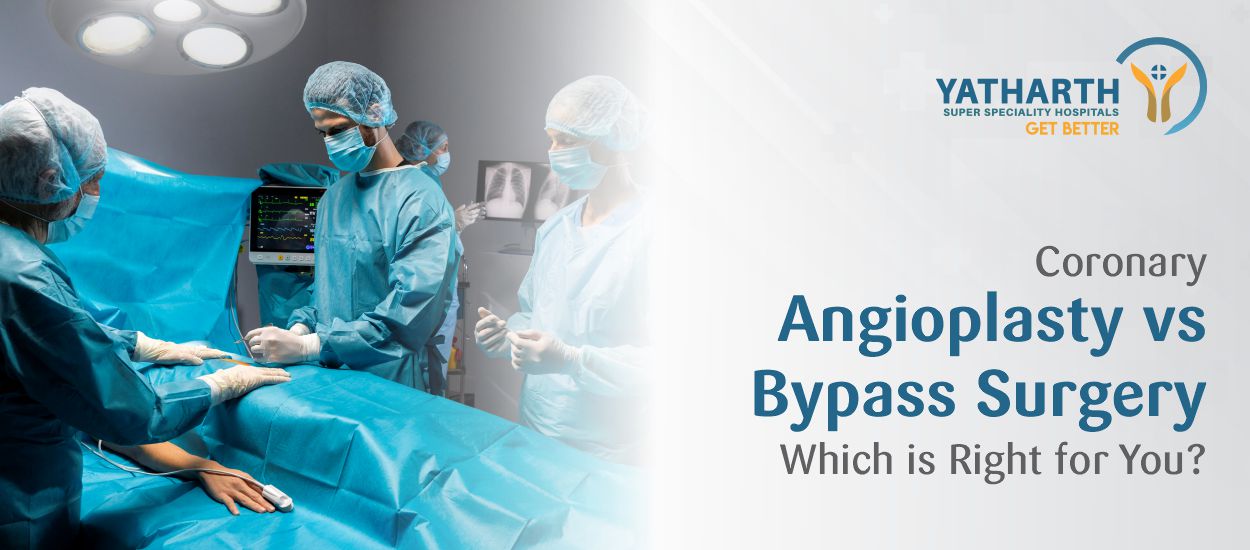An Overview
Both coronary angioplasty and coronary bypass surgery are procedures that treat blocked or narrowed coronary arteries. These are major blood vessels supplying blood to your heart. After a heart attack, doctors may undertake a preventive procedure either in the form of angioplasty or coronary bypass.
Both procedures will improve the flow of blood to your heart if the coronary artery has been blocked or narrowed. The blood vessels could be blocked or constricted due to plaque build-up, a condition termed atherosclerosis. If it is not treated well in time, atherosclerosis could trigger a heart attack. As a result, coronary artery disease (CAD) remains the most common cause of major sickness and death in the world.
Some Inherent Risks
Since both options have a few inherent risks, the doctor will decide the procedure that suits you better, depending on varied issues. Keeping in mind the heart disease’s severity and allied factors, both procedures have some element of risk that may lead to death. Therefore, it is important to understand the potential risks of both procedures.
Risks associated with Coronary Angioplasty may include renarrowing of artery, an allergic reaction to the contrast dye, stroke, or blood clots. . Rare risks could include heart attack or coronary artery damage.
Coronary bypass risks include reduced kidney function, infection, stroke and heart attack, particularly in the month following the surgery.
Angioplasty versus Bypass Effectiveness
Similarly, the effectiveness of each procedure may differ. In most cases, angioplasty will improve the flow of blood via your coronary artery. This makes angioplasty with stenting the treatment of choice in unstable angina, heart attack and spontaneous coronary artery dissection. After a heart attack, angioplasty can be a lifesaver.
Coronary artery bypass grafting (CABG) surgery is indicated for patients who have coronary artery disease – triple vessel disease with diabetes mellitus. For a focal lesion, angioplasty is preferred.
As for coronary bypass, research indicates it could lower death rates for up to a decade compared to only using medications in people who have reduced left ventricular function with inadequate flow of blood to the heart. Coronary bypass surgery for people with CAD could mean less angina (chest pain or discomfort), higher survival rates and better quality of life.
The Angioplasty Procedure
Typically, an angioplasty will take anywhere between half an hour and two hours. The procedure could usually see the patient:
• Lying on an X-ray table and administered a local anaesthetic and an IV (intravenous) line to deliver pain relievers, sedatives or a contrast dye.
• A small incision is made in the person’s groin, arm or wrist by a cardiologist to access an artery.
• A sheath inserted in the artery keeps it open and a catheter is then inserted into this sheath.
• A slim wire with a thin balloon is passed via the catheter until it reaches the coronary artery.
• To open the coronary artery, the balloon is then inflated for 20 to 30 seconds.
• If a stent is being implanted, the balloon helps to put it in place.
The Bypass Procedure
Generally, coronary bypass surgery could last between three and six hours. The surgeon will:
• Give the patient general anaesthesia via an IV so he/she is asleep during the procedure.
• Make an incision along the patient’s sternum to open the rib cage.
• Administer a drug to stop the heart. A connected machine takes over the heart and lung functions.
• Remove a blood vessel from the leg, chest or arm to create a graft; multiple grafts may be needed.
• Create a bypass around the blockage by using the extracted blood vessel.
A coronary bypass may sometimes be performed without needing to stop the patient’s heart.
Preparing for Angioplasty
For a non-emergency procedure, the cardiologist will properly plant the angioplasty procedure after stabilizing the patient.
Preparing for Bypass
Since bypass has a long recovery period, the patient must prepare by:
• Arranging for a driver/vehicle to return home from the hospital.
• Organising some house help for a fortnight.
• Preparing the home in advance to support personal comfort and mobility.
Recovery Period
The recovery timelines for both procedures vary. In angioplasty, you could go home the same day or need to stay overnight in the hospital. In a non-emergency coronary angioplasty, most people could return to work within a week or so.
For bypass, you will need to be hospitalised for around 7 days following the procedure. Most patients will make a complete recovery within three months.
Alternatives to Angioplasty and Bypass Surgery
For people with CAD who wish to avoid surgery, there are other preventive treatment options. These include lifestyle modification strategies such as having a regular exercise regimen, limiting intake of trans-fats and saturated fats and not smoking. It’s also advisable to avoid alcohol, particularly if you already have a heart condition. Alcohol consumption is considered a common trigger for atrial fibrillation (a kind of abnormal heart rhythm).
Medications such as blood thinners, statins, beta-blockers, nitrates, ACE inhibitors and calcium channel blockers, among others, could also help in managing CAD. However, these medications can only be taken if prescribed by your cardiologist.
Which Option is Better – Angioplasty or Bypass Surgery?
While your cardiologist will be best placed to decide which option would suit you, angioplasty is a quicker, less invasive procedure compared to a bypass. But bypass may be a better alternative if there are multiple blockages or the left main coronary artery is blocked.
Coming to survival rates between the two procedures, a review of studies in 2023 showed there was no major difference in angioplasty with stenting and a bypass a decade after the procedure. Nonetheless, a coronary bypass being more extensive, it lets blood circumnavigate a blockage completely.
On the other hand, an angioplasty may not be recommended in some conditions. These include having small blood vessels, bruising of blood vessels, no tolerance for antiplatelet therapy, an allergy to stent components, an active malignancy with lower life expectancy, a recent haemorrhagic stroke and high bleeding risk or active bleeding.
It must be reiterated that your cardiologist is the best person to determine whether an angioplasty or coronary bypass surgery will be more beneficial for you. Conversely, if you only have a minor narrowing of the arteries, the doctor may recommend medications or lifestyle change strategies.
















